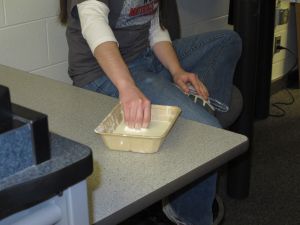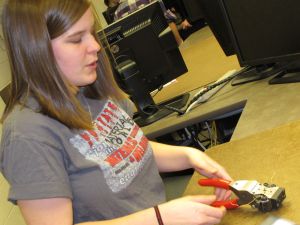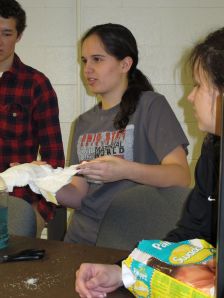OSU STEM Event for High School Juniors
February 23, 2013 Leave a comment
It’s not easy for college students to get up early on a Saturday morning, but 5 OSU Materials Science and Engineering students did that today to talk to visiting high school juniors about “Materials for Everyday Use.”
Two groups of 35 students visited the MSE demos. They divided into 4 groups, then rotated to the 4 stations of materials demos.
Click the photos for more info and fun.
1) Oobleck
MSE sophomore Katrina showed students “oobleck,” a mixture of cornstarch and water that has the properties of a non-Newtonian fluid. This means that it behaves as a liquid or a solid, depending on the kind of force that is applied to it. Punch it, and it turns to a solid. Gently touch it, and your fingers get sticky.
Materials with similar properties are being used in protective gear where there is danger of stabbing. Kevlar has been used to bulletproof the gear, but sharp objects like spikes can fit through the woven Kevlar fibers. A non-Newtonian fluid can be interspersed with the Kevlar, and stop the entry of a sharp weapon.
2) Shape Memory Alloy – Nitinol
Graduating senior Eric demonstrated the ever-popular Script Ohio made from nitinol. Nitinol is a “shape memory alloy” made of nickel and titanium.
Its “memory” properties mean that its shape can be deformed, and then brought back to its “remembered” shape with the addition of some energy (heat, electricity, etc.) First discovered in the 1950s, the alloy was not widely used until recently when advanced technology allowed for its machining and processing.
Everyday uses: eyeglasses, orthodontics, heart stents, safety equipment
3) Solid State Welding
Few materials are useful in building and manufacturing unless they also can be joined or welded. Junior Maryellen showed students an example of solid state welding with a hand-held wire welder.
In this example, two pieces of copper wire are welded by the machine that squeezes the wires in such close proximity to each other that the metals’ electrons bond, forming one continuous piece.
This particular machine is used to join electrical wire. Other examples of solid state welding are explosion welding and and friction stir welding.
4) Materials in Disposable Diapers
Ever dissect a wet diaper? Freshman Rachel and Junior Janelle demonstrated the absorption power of Pampers while discussing the various materials they’re made of. Superabsorbent polymer balls are the secret ingredient to the cotton and paper pulp diaper filler. Diapers contain elastics, waterproof layers, and adhesives all put together in a complex manufacturing process.
Other considerations for materials engineers: processing, disposal, hygiene, compatibility with babies’ skin, ease of use
So despite the early start on a Saturday, we had a lot of fun sharing everyday uses for the materials we study.
Now, it’s time for nap!





